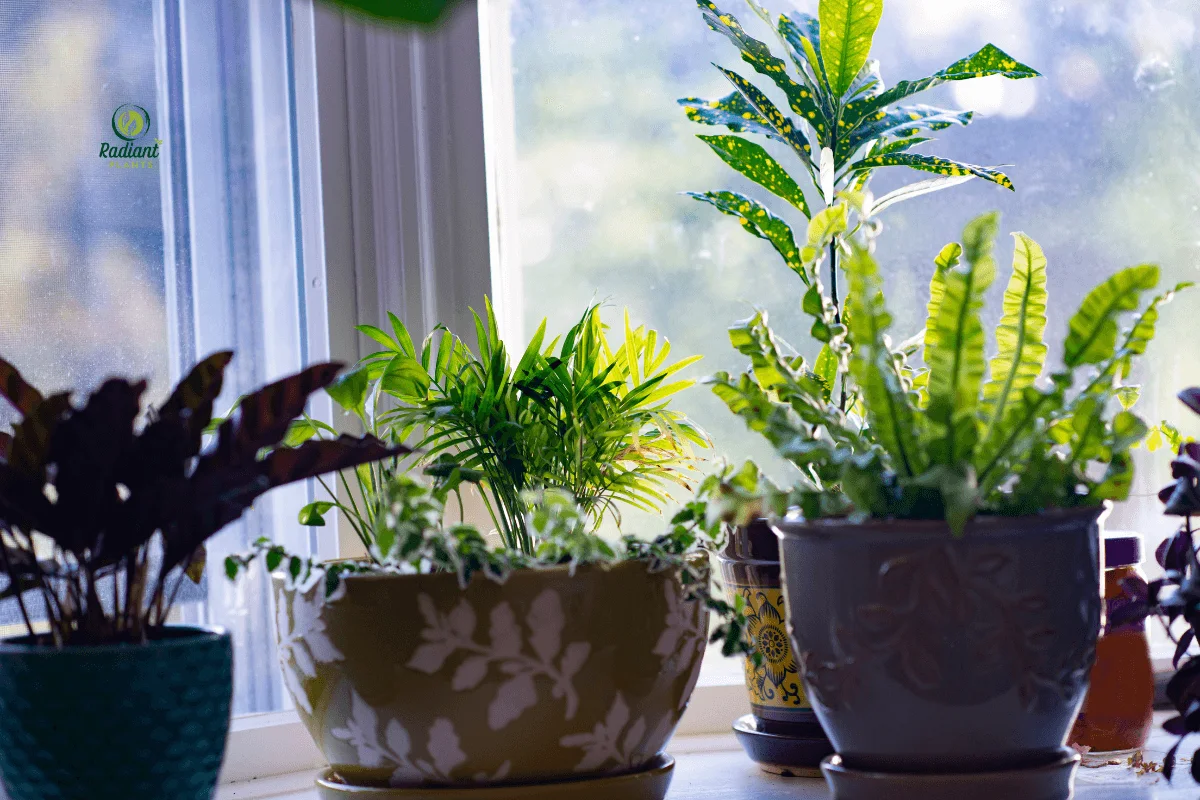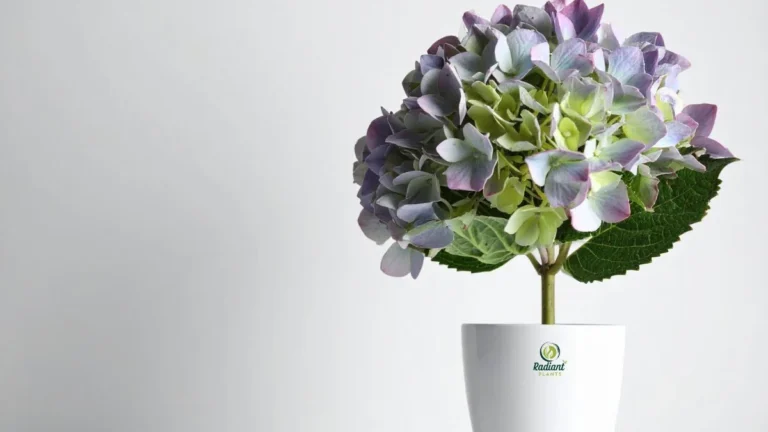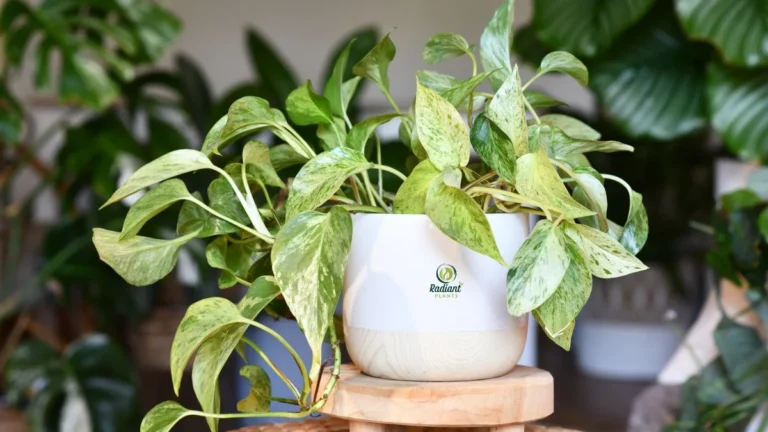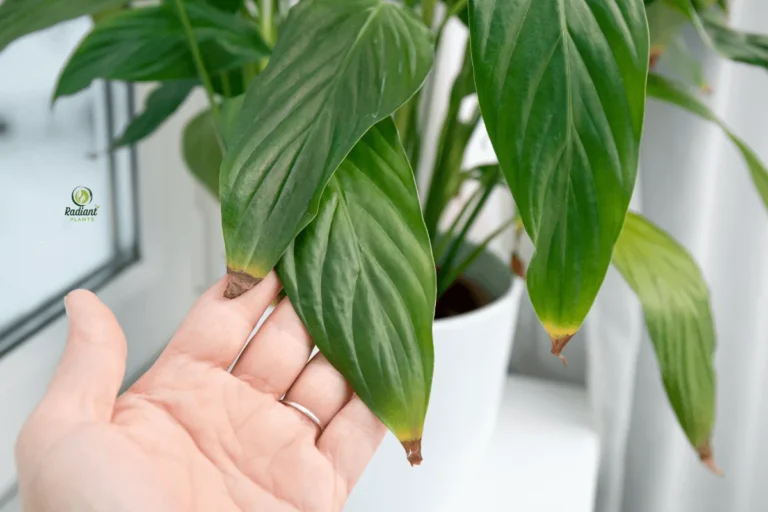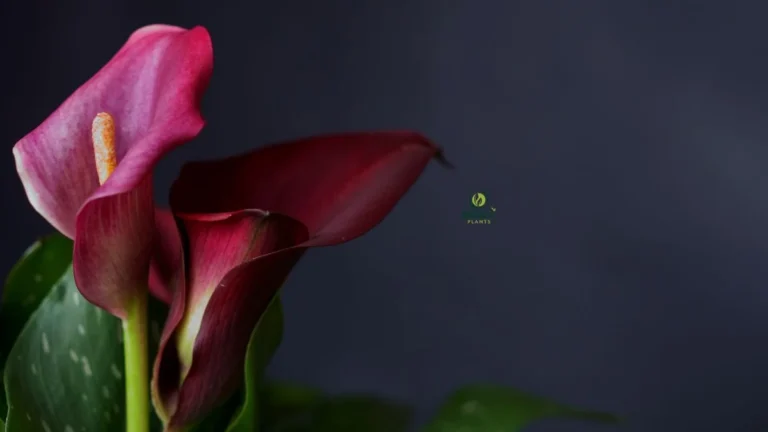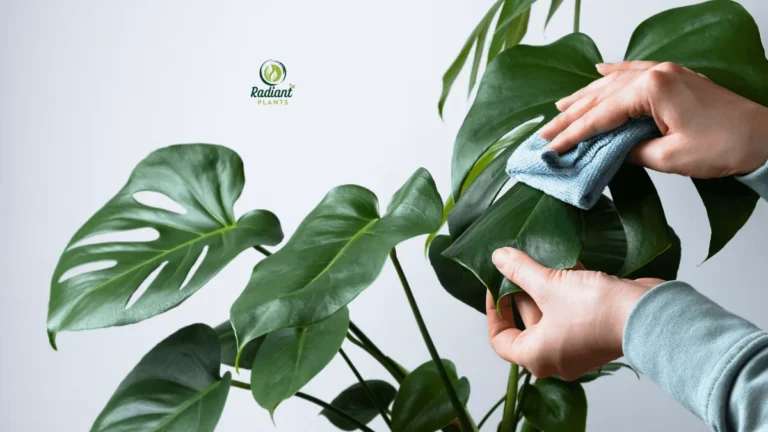Little Plants Indoor Care: How to Keep Tiny Plants Happy
Caring for little plants indoor requires understanding their unique needs compared to larger houseplants. These compact beauties need more frequent attention because their small containers dry out faster, their roots have limited space to spread, and they’re more sensitive to environmental changes.
The secret to keeping tiny houseplants thriving isn’t complicated—it’s about adjusting your care routine to match their petite size. Small pots mean quicker watering cycles, careful fertilizer portions, and strategic placement away from harsh conditions that larger plants can easily tolerate.
Whether you’re struggling with dying desk plants or want to expand your little plants indoor collection indoors, mastering these fundamentals will transform you from a plant killer into a green-thumb guru. Let’s dive into the essential care techniques that keep compact houseplants happy, healthy, and growing strong in any space.
Table of Contents
Table of Contents
Why Little Plants Indoor Need Special Care and Attention
Little plants indoors require more frequent watering, careful monitoring, and adjusted care routines because their small containers create unique challenges that don’t affect larger houseplants.
Understanding why little plants indoor need different care approaches is crucial for keeping them alive and thriving. Unlike their larger counterparts, compact houseplants face three primary challenges that directly impact their health and survival.
The Container Size Challenge
Small containers create a completely different growing environment compared to standard-sized pots. The reduced pot volume means:
• Less soil buffer – Changes in moisture and nutrients happen rapidly • Quick temperature fluctuations – Small pots heat up and cool down faster • Limited stability – Lightweight containers can tip over easily • Faster nutrient depletion – Plants exhaust available nutrients more quickly
This size constraint means your tiny houseplants need more consistent attention than large floor plants that can coast for weeks between care sessions.
Limited Root Space Issues
Cramped root systems in small pots create cascading problems that affect overall plant health:
Restricted Growth Patterns Roots quickly become pot-bound, leading to circular root growth that inhibits nutrient uptake. This constraint forces the plant to work harder for basic survival needs.
Increased Stress Sensitivity With nowhere to expand, roots become more vulnerable to: • Overwatering damage from poor drainage • Salt buildup from fertilizers • Fungal infections in compacted soil • Shock from environmental changes
Stunted Development Limited root space directly impacts leaf growth, flowering potential, and overall plant vigor. Small indoor plants may appear healthy but struggle to reach their full potential without adequate root room.
Faster Drying Soil Problems
Perhaps the most critical difference is how quickly small containers lose moisture:
Accelerated Water Loss • Surface area ratio – More soil surface exposed relative to volume • Container material – Terracotta and ceramic dry faster than plastic • Environmental factors – Heating, air conditioning, and fans affect small pots more dramatically
Watering Frequency Adjustments While large plants might need water weekly, little plants indoor often require attention every 2-3 days during active growing seasons. This creates a delicate balance:
• Too frequent watering leads to root rot • Too infrequent watering causes immediate stress and leaf drop • Inconsistent scheduling confuses the plant’s adaptation mechanisms
Big Plants vs Little Plants Care Comparison
Care Aspect | Big Plants (6″+ pots) | Little Plants (4″ or smaller) |
|---|---|---|
Watering Frequency | 7-14 days | 2-5 days |
Soil Check Method | Finger 2″ deep | Finger 1″ deep |
Fertilizer Strength | Full strength monthly | 2-4 weeks after stress |
Temperature Tolerance | ±10°F fluctuation | ±5°F fluctuation |
Repotting Schedule | Every 2-3 years | Every 1-2 years |
Recovery Time | 1-2 weeks after stress | 1-2 weeks from stress |
Placement Flexibility | Floor, corners, tables | Desks, shelves, windowsills |
Light Adjustment | Gradually over the weeks | Immediate response needed |
Humidity Needs | Moderate attention | Critical monitoring |
Cost of Mistakes | Slower decline | Rapid deterioration |
Key Takeaway: The smaller the pot, the more responsive your care routine needs to be. Compact houseplants require a proactive rather than reactive approach to maintenance.
Understanding these fundamental differences helps explain why traditional houseplant advice often fails with little plants indoor. Their unique challenges demand adjusted techniques, but the reward is having thriving greenery that fits perfectly into any living space.
Essential Care Fundamentals for Little Plants Indoor
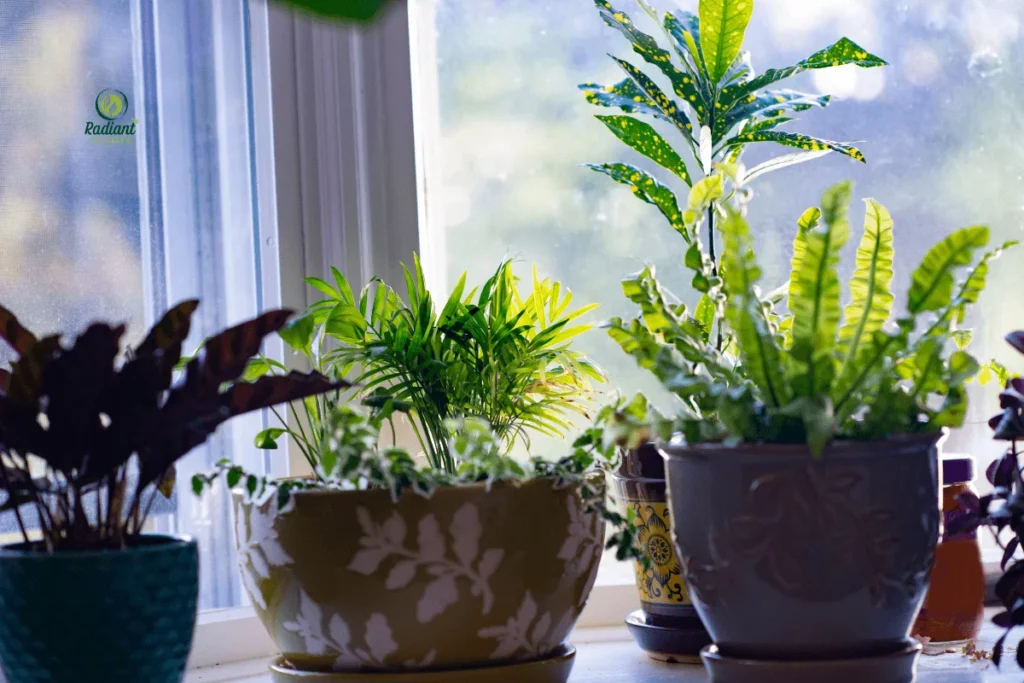
Successful little plants indoor care requires proper drainage containers, well-draining soil mix, frequent but light watering, and strategic light placement to compensate for their compact growing environment.
Mastering the fundamentals of little plants indoor care transforms struggling houseplants into thriving green companions. These four core principles address the unique challenges small plants face and create the foundation for long-term success.
Right-Sized Containers and Drainage
Container selection makes or breaks small plant health. The perfect pot balances size, drainage, and aesthetics:
Size Guidelines:
• 2-4 inch pots for starter plants and propagations
• 4-6 inch containers for established small houseplants
• Never upsize more than 2 inches at repotting time
• Width over depth – shallow, wide pots work better than deep, narrow ones
Drainage Essentials: Proper drainage is non-negotiable for compact houseplants. Every container must have:
• Multiple drainage holes – minimum 3-5 holes for 4-inch pots
• Drainage layer – pebbles or pottery shards in the bottom inch
• Saucer protection – prevent water damage to surfaces
• Material matters – terracotta breathes better than plastic for moisture control
Red Flags to Avoid:
- Decorative pots without drainage holes
- Containers are too large for the root system
- Glass containers that trap moisture
- Heavy ceramic pots that stress small root systems
Soil Mix That Works for Small Pots
Standard potting soil often retains too much moisture for small indoor plants. Create the ideal growing medium:
Base Recipe for Small Containers:
• 50% quality potting mix – provides nutrients and structure
• 25% perlite – ensures drainage and aeration
• 15% orchid bark – prevents compaction
• 10% worm castings – gentle, slow-release nutrition
Alternative Quick Mix: For busy plant parents, combine:
• 2 parts succulent/cactus soil
• 1 part regular potting mix
• Handful of perlite
Soil Performance Indicators: ✅ Good mix: Water drains within 10-15 seconds
✅ Proper texture: Crumbles easily, doesn’t clump when squeezed
✅ Moisture retention: Damp but not soggy 24 hours after watering
❌ Problem signs: Water pools on surface, soil stays wet 3+ days, compacted or rock-hard texture
Watering Frequency Guidelines
Little plants indoor need more frequent but lighter watering sessions compared to large houseplants:
The Finger Test Method:
• Check daily during the growing season (spring/summer)
• Insert finger 1 inch deep into the soil
• Water when the top inch feels dry, but the soil below is slightly moist
• Skip watering if the soil sticks to your finger
Watering Technique:
• Water thoroughly until it drains from the bottom holes
• Empty saucers after 30 minutes to prevent root rot
• Use room temperature water to avoid shocking small root systems
• Morning watering allows plants to process moisture during daylight
Seasonal Adjustments:
- Summer: Every 2-3 days, typical frequency
- Winter: Reduce to every 5-7 days as growth slows
- Humidity changes: Air conditioning and heating affect soil drying rates
Light Requirements in Limited Space
Small houseplants adapt their light needs based on available space and placement options:
Strategic Placement Tips:
• Bright, indirect light works for 80% of compact plants
• 2-3 feet from south-facing windows prevents leaf burn
• Rotate weekly to ensure even growth
• Supplement with grow lights in dark corners or winter months
Space-Specific Solutions:
- Desk areas: LED grow light strips under shelves
- Bathroom placement: Humidity lovers near shower areas
- Bedroom options: Low-light tolerant plants away from windows
- Kitchen counters: Herbs and small edibles near sink areas
Daily, Weekly, Monthly Care Checklist
Daily Tasks (2 minutes)
- [ ] Visual health check for yellowing or drooping leaves
- [ ] Finger test soil moisture in actively growing plants
- [ ] Rotate plants 1/4 turn if near windows
- [ ] Remove any dead or yellowing leaves immediately
Weekly Tasks (10-15 minutes)
- [ ] Thorough watering session for plants that need it
- [ ] Check drainage saucers and empty excess water
- [ ] Inspect for pest activity (tiny bugs, webbing, spots)
- [ ] Wipe down leaves with a damp cloth for dust removal
- [ ] Assess light levels and adjust placement if needed
Monthly Tasks (30-45 minutes)
- [ ] Diluted fertilizer application during the growing season
- [ ] Deep cleaning of plant containers and saucers
- [ ] Pruning and deadheading spent blooms
- [ ] Root check for pot-bound plants needing repotting
- [ ] Photography progress tracking for growth monitoring
- [ ] Inventory and replace any struggling plants
Pro Tip: Consistency beats perfection. Following this routine little plants indoor care schedule prevents most common problems before they become serious issues.
These fundamentals create the framework for healthy compact houseplants that thrive rather than merely survive in your home environment.
8 Foolproof Little Plants Indoor That Always Thrive
These 8 little plants indoor varieties, are virtually indestructible and perfect for beginners: pothos, snake plants, ZZ plants for easy care, plus peace lilies and cast iron plants for low light areas.
Choosing the right little plants indoor eliminates 90% of houseplant failures. These eight proven performers adapt to various conditions, forgive care mistakes, and stay compact enough for any space. Each plant earned its spot through consistent success with both beginner and experienced plant parents.
Beginner-Friendly Options (3 Plants)
These three small houseplants are virtually indestructible and perfect for building confidence:
1. Pothos (Epipremnum aureum) The ultimate starter plant that grows in water or soil:
• Why it’s foolproof: Tolerates neglect, low light, and irregular watering
• Compact care: Trail from shelves or train around small trellises
• Growth habit: Vines stay manageable with occasional trimming
• Success indicator: New leaves mean you’re doing everything right
2. Snake Plant (Sansevieria trifasciata) Architectural beauty that thrives on neglect:
• Drought tolerance: Can survive 2-3 weeks without water
• Space efficiency: Grows upright, perfect for tight corners
• Air purification: NASA-approved for removing indoor toxins
• Beginner bonus: Yellow leaves mean overwatering—easy to fix
3. ZZ Plant (Zamioculcas zamiifolia) The “set it and forget it” plant for busy lifestyles:
• Water schedule: Monthly watering during the growing season
• Light flexibility: Thrives in bright indirect to low light
• Growth pattern: Stays naturally compact and symmetrical
• Recovery ability: Bounces back from most care mistakes quickly
Low-Light Champions (3 Plants)
These compact houseplants excel in darker corners and interior spaces:
4. Peace Lily (Spathiphyllum). Elegant flowers that signal watering needs:
• Light requirements: Flourishes in office fluorescent lighting
• Water indicator: Dramatic drooping tells you when to water
• Flower bonus: White blooms appear several times yearly
• Size control: Dwarf varieties stay under 12 inches tall
5. Cast Iron Plant (Aspidistra elatior) Victorian-era survivor that tolerates everything:
• Extreme tolerance: Handles neglect, temperature swings, and poor light
• Slow growth: Stays a manageable size for years without repotting
• Pest resistance: Rarely bothered by insects or diseases
• Placement freedom: Thrives in bathrooms, bedrooms, or dark hallways
6. Chinese Evergreen (Aglaonema) Colorful foliage that brightens dim spaces:
• Variety of options: Silver, pink, red, and green leaf patterns available
• Low maintenance: Weekly watering and monthly fertilizing
• Compact growth: Most varieties stay under 18 inches
• Visual appeal: Decorative leaves provide constant color interest
Compact Flowering Varieties (2 Plants)
Add blooms to your little plants indoor collection with these reliable flowerers:
7. African Violet (Saintpaulia) Classic tabletop plant with continuous blooms:
• Flowering schedule: Blooms year-round with proper care
• Size advantage: Stays naturally small in 4-6 inch pots
• Color variety: Purple, pink, white, and bi-color options
• Care secret: Bottom watering prevents leaf spotting
8. Kalanchoe (Kalanchoe blossfeldiana) Succulent with long-lasting flower clusters:
• Bloom duration: Flowers last 6-8 weeks per flowering cycle
• Water needs: Drought-tolerant succulent requires minimal care
• Compact habit: Dense, bushy growth perfect for windowsills
• Seasonal timing: Natural winter bloomer brightens dark months
Plant Care Quick Reference Guide
Plant Name | Light Needs | Water Frequency | Care Difficulty | Special Notes |
|---|---|---|---|---|
Pothos | Low to bright indirect | Weekly | ⭐ Beginner | Grows in water |
Snake Plant | Low to bright indirect | Bi-weekly | ⭐ Beginner | Extremely drought tolerant |
ZZ Plant | Low to medium | Monthly | ⭐ Beginner | Glossy leaves, slow growth |
Peace Lily | Low to medium | Weekly | ⭐⭐ Easy | Droops when thirsty |
Cast Iron Plant | Low to medium | Bi-weekly | ⭐ Beginner | Victorian-era classic |
Chinese Evergreen | Low to medium | Weekly | ⭐⭐ Easy | Colorful foliage patterns |
African Violet | Bright indirect | Twice weekly | ⭐⭐⭐ Moderate | Bottom watering only |
Kalanchoe | Bright indirect | Bi-weekly | ⭐⭐ Easy | Succulent with flowers |
Success Tips for All 8 Plants:
Universal Care Principles:
• Start small: 4-6 inch pots are perfect for these varieties
• Quality soil: Well-draining potting mix prevents most problems
• Consistent routine: Regular care schedule beats sporadic attention
• Observation skills: Watch your plants—they communicate their needs
Troubleshooting Made Simple:
- Yellow leaves: Usually overwatering (reduce frequency)
- Brown leaf tips: Low humidity or fluoride in water
- Leggy growth: Needs more light or pruning
- No growth: Normal during the winter dormancy period
These eight little plants indoor varieties have proven themselves in countless homes, apartments, and offices. Choose one or two to start, master their care, then expand your collection with confidence. Success with these plants builds the foundation for more adventurous houseplant choices later.
Common Little Plants Indoor Care Mistakes (And How to Fix Them)
The four most common little plants indoor care mistakes are overwatering small containers, choosing the wrong pot sizes, ignoring humidity requirements, and over-fertilizing tiny root systems—all easily preventable with proper knowledge.
Even experienced gardeners struggle with little plants indoor because compact houseplants require different approaches than large floor plants. These four critical mistakes account for 80% of small plant failures, but understanding the warning signs and solutions transforms plant killers into successful indoor gardeners.
Overwatering in Small Containers
The #1 killer of small houseplants stems from applying large-plant watering habits to tiny containers:
Why Small Pots Fail Faster:
• Limited drainage volume – Water has nowhere to escape quickly
• Soil stays saturated longer – Less soil means slower drying
• Root rot develops rapidly – Compact root systems can’t escape wet conditions
• Anaerobic conditions – Waterlogged soil prevents oxygen from reaching roots
Warning Signs of Overwatering:
- Yellow leaves starting from the bottom of the plant
- Musty or sour smell from the soil
- Black, mushy roots are visible at the drainage holes
- Fungus gnats are hovering around the soil surface
- Soil that stays wet 3+ days after watering
Immediate Fix Protocol:
- Stop watering immediately and assess damage
- Remove the plant from the soggy soil if the roots are black/mushy
- Trim damaged roots with clean scissors
- Repot in fresh, well-draining soil mix
- Wait 7-10 days before resuming normal watering schedule
Prevention Strategy: • Use the finger test: water only when the top inch feels dry • Ensure proper drainage holes in every container • Switch to terracotta pots for better moisture control • Water thoroughly but less frequently
Wrong Pot Size Selection
Tiny houseplants suffer when planted in containers that are too large or too small:
“Too Big” Container Problems: • Excess soil holds water longer than roots can absorb • Root system can’t fill space efficiently, leading to soggy pockets • Plant energy goes to root development instead of leaf growth • Increased risk of root rot in unused soil areas
“Too Small” Container Issues: • Roots become severely pot-bound and can’t absorb nutrients • Soil dries out too quickly, requiring daily watering • Plant becomes top-heavy and tips over easily • Stunted growth from restricted root development
Perfect Pot Sizing Rules: ✅ Ideal size: 1-2 inches larger in diameter than the current pot
✅ Depth consideration: Wide and shallow beats deep and narrow
✅ Material matters: Terracotta for moisture control, plastic for retention
✅ Drainage mandatory: Minimum 3-5 holes for adequate water escape
Ignoring Humidity Needs
Indoor air is often too dry for compact houseplants, especially during heating and cooling seasons:
Low Humidity Problems: • Brown, crispy leaf edges from moisture stress • Increased pest susceptibility – spider mites love dry conditions • Slow growth and poor flowering in humidity-loving species • Premature leaf drop as plants conserve moisture
Quick Humidity Solutions:
- Pebble trays: Place plants on saucers filled with wet pebbles
- Group plants together: Creates natural humidity microclimates
- Bathroom placement: Utilize natural shower and bath humidity
- Humidifier investment: Maintain 40-60% humidity levels year-round
DIY Humidity Hacks: • Spray bottles with distilled water (avoid tap water mineral buildup) • Shallow dishes of water placed near plant clusters • Wet towels draped over radiators during winter months
Fertilizer Burns in Tiny Plants
Little plants indoor need much less fertilizer than their larger cousins, making over-fertilization a common mistake:
Over-Fertilization Symptoms: • White crusty buildup on soil surface or pot edges • Brown, burned leaf tips despite adequate watering • Wilting plants in moist soil conditions • Slowed growth despite optimal care conditions
Safe Fertilizing Guidelines:
- Dilute to half the strength of the package recommendations
- Fertilize every 4-6 weeks during the growing season only
- Skip winter feeding when plants are dormant
- Flush the soil monthly with plain water to prevent salt buildup
Complete Troubleshooting Guide
Emergency Symptoms & Solutions
Problem | Immediate Cause | Quick Fix | Prevention |
|---|---|---|---|
Yellow bottom leaves | Overwatering | Stop watering 7-10 days | Finger test before watering |
Brown leaf tips | Low humidity/over-fertilization | Increase humidity, and flush the soil | Use a humidifier, dilute fertilizer |
Musty soil smell | Root rot from wet conditions | Repot in fresh soil immediately | Improve drainage, reduce watering |
Tiny flying bugs | Fungus gnats from overwatering | Let the soil dry completely | Water only when the soil is dry |
Wilting in wet soil | Root damage or fertilizer burn | Check roots, flush with plain water | Gentle fertilizing, proper drainage |
No new growth | Normal winter dormancy | Reduce water/fertilizer, wait | Accept seasonal growth patterns |
Leggy, stretched growth | Insufficient light | Move closer to the light source | Rotate weekly, supplement with grow lights |
White crust on the soil | Fertilizer salt buildup | Flush with distilled water | Use diluted fertilizer, and better water quality |
Weekly Plant Health Checklist
Monday Motivation Check:
- [ ] Visual inspection for pest activity or unusual symptoms
- [ ] Soil moisture assessment using the finger test method
- [ ] Leaf cleaning with a damp cloth to remove dust buildup
Thursday Troubleshooting:
- [ ] Check for early warning signs of overwatering or pests
- [ ] Assess light levels and rotate plants if needed
- [ ] Remove any dead or yellowing leaves immediately
Sunday Success Review:
- [ ] Weekly watering session for plants that need it
- [ ] Photo documentation of any concerning changes
- [ ] Plan adjustments for the upcoming week’s care routine
Avoiding these common mistakes with little plants indoor care creates thriving houseplants that reward your attention with healthy growth and beautiful foliage. Prevention always beats treatment when it comes to compact houseplant success.
Seasonal Care Adjustments for Little Plants Indoor
Little plants indoor need seasonal care adjustments, including increased watering and fertilizing in spring/summer, heat protection and humidity boosts during hot months, gradual reduction in fall, and minimal care during winter dormancy.
Understanding seasonal rhythms transforms little plants indoor care from guesswork into predictable success. These compact houseplants respond dramatically to changing daylight hours, temperature fluctuations, and humidity levels throughout the year, requiring adjusted care routines for optimal health.
Spring Growth Boost Tips
Spring awakens small houseplants from winter dormancy, triggering rapid growth and increased care needs:
Growth Activation Signals: • New leaf emergence – Fresh green shoots appear after months of dormancy • Increased water consumption – Soil dries faster as metabolism accelerates • Root activity surge – Plants may become pot-bound quickly • Color intensification – Foliage becomes more vibrant with active growth
Spring Care Adjustments:
- Resume fertilizing schedule: Start with half-strength fertilizer every 4 weeks
- Increase watering frequency: Check soil moisture every 2-3 days instead of weekly
- Repotting window: Best time for root-bound plants needing larger containers
- Light positioning: Move plants closer to windows as days lengthen
Spring Maintenance Tasks: • Prune any winter damage or leggy growth • Clean leaves thoroughly to maximize photosynthesis • Check for pest activity as insects become more active • Rotate plants weekly to encourage even growth
Summer Heat Protection
Hot summer months stress compact houseplants with intense light, high temperatures, and low humidity:
Heat Stress Warning Signs:
- Wilting despite adequate soil moisture
- Leaf edges are turning brown or crispy
- Accelerated soil drying (daily watering needs)
- Fading or bleaching of colorful foliage
Summer Protection Strategies:
• Move away from hot windows: South-facing windows can scorch leaves
• Increase humidity dramatically: Use humidifiers, pebble trays, or plant groupings
• Water more frequently: Small pots dry out rapidly in the heat
• Provide air circulation: Gentle fans prevent stagnant air and fungal issues
Heat Wave Emergency Protocol:
- Relocate immediately to cooler, shadier locations
- Increase humidity to 60%+ using all available methods
- Water early morning to prevent rapid evaporation
- Create shade barriers with sheer curtains or plant placement
Fall Preparation Guidelines
Autumn prepares little plants indoor for winter dormancy through gradual care adjustments:
Fall Transition Indicators:
• Slowing growth rate – New leaves appear less frequently
• Reduced water uptake – Soil stays moist longer between waterings
• Color changes – Some plants develop seasonal leaf coloration
• Natural leaf drop – Older leaves yellow and fall, as energy is conserved
Gradual Care Reduction:
- Decrease fertilizing: Switch to every 6-8 weeks with quarter-strength solution
- Reduce watering frequency: Extend intervals as plant metabolism slows
- Stop repotting: Allow plants to settle into dormancy undisturbed
- Pest prevention: Inspect thoroughly before heating season begins
Fall Preparation Checklist:
□ Deep clean all leaves to remove dust and pests
□ Check drainage systems before the rainy season
□ Assess winter light locations and plan relocations
□ Harvest any edible plants before the first temperature drop
Winter Dormancy Care
Winter dormancy requires minimal intervention for tiny houseplants as they rest and conserve energy:
Dormancy Recognition:
• Minimal to no new growth for 2-3 months
• Reduced water needs – soil stays moist 5-7 days
• Potential leaf drop – Normal energy conservation response
• Slower response to environmental changes
Winter Care Minimums:
- Water sparingly: Only when the top 2 inches feel completely dry
- No fertilizing: Plants cannot process nutrients during dormancy
- Maintain temperatures: Keep above 60°F but avoid heat sources
- Maximize available light: Move to the brightest available locations
Winter Survival Essentials:
• Humidity maintenance: Heating systems create desert-like conditions
• Temperature stability: Avoid drafts, vents, and temperature swings
• Pest monitoring: Dry indoor air attracts spider mites and scale
• Patience practice: Resist the urge to “help” dormant plants with extra care
Monthly Care Calendar for Little Plants Indoor
Month | Light Hours | Water Frequency | Fertilizer | Key Tasks | Humidity Needs |
|---|---|---|---|---|---|
January | 9-10 hours | Every 7-10 days | None | Monitor only, pest check | 40-50% (humidifier essential) |
February | 10-11 hours | Every 5-7 days | None | Prepare for spring, clean leaves | 40-50% (heating season peak) |
March | 11-12 hours | Every 4-6 days | Quarter strength | Resume growth care, report if needed | 45-55% (spring humidity rise) |
April | 12-13 hours | Every 3-5 days | Half strength | The active growth period begins | 50-60% (natural humidity increase) |
May | 13-14 hours | Every 3-4 days | Half strength | Peak growing season, weekly rotation | 50-60% (comfortable levels) |
June | 14-15 hours | Every 2-3 days | Full strength | Heat protection, humidity boost | 55-65% (summer humidity needed) |
July | 14-15 hours | Every 2-3 days | Full strength | Peak summer care, heat stress watch | 60-70% (maximum humidity needs) |
August | 13-14 hours | Every 2-3 days | Full strength | Continue summer protection | 60-70% (still hot and dry) |
September | 12-13 hours | Every 3-4 days | Half strength | Begin fall transition | 55-65% (gradual reduction) |
October | 11-12 hours | Every 4-5 days | Quarter strength | Prepare for dormancy | 50-60% (fall adjustment) |
November | 10-11 hours | Every 5-7 days | None | Early dormancy period | 45-55% (heating begins) |
December | 9-10 hours | Every 7-10 days | None | Full dormancy, minimal care | 40-50% (winter survival mode) |
Seasonal Success Tips:
Universal Principles:
• Observe before acting – Plants communicate their seasonal needs clearly
• Gradual transitions – Sudden changes shock small root systems
• Regional adjustments – Southern climates may not require full dormancy
• Individual plant needs – Some species ignore seasonal patterns
Climate Considerations:
- Northern regions: Longer, deeper dormancy periods required
- Southern areas: May continue slow growth year-round
- Apartment living: Consistent temperatures modify natural cycles
- Office environments: Artificial lighting affects seasonal responses
Mastering seasonal care for little plants indoor creates thriving houseplants that follow natural rhythms while adapting to indoor environments. This cyclical approach prevents overcare during dormancy and maximizes growth during active periods.
Space-Specific Placement Guide for Little Plants Indoor
Strategic little plants indoor placement maximizes success by matching plant needs with room conditions: bedrooms need air-purifying varieties, bathrooms suit humidity lovers, offices require low-maintenance options, and kitchens favor herbs and compact edibles.
Successful little plants indoor placement goes beyond aesthetics—it’s about matching plant requirements with the unique environmental conditions each room provides. Understanding microclimates within your home transforms random plant placement into strategic success.
Bedroom Plant Placement
Bedrooms offer unique conditions for small houseplants with consistent temperatures and limited light exposure:
Bedroom Environmental Factors:
• Lower light levels – Often far from windows with curtains drawn
• Stable temperatures – Usually 65-72°F year-round for comfort
• Higher CO2 at night – Occupants exhale carbon dioxide while sleeping
• Limited air circulation – Doors closed, minimal airflow
Best Bedroom Plant Choices:
- Snake Plants (Sansevieria): Release oxygen at night, perfect air purifiers
- Peace Lilies: Tolerant of low light and improve air quality
- ZZ Plants: Thrive in dim corners and require minimal care
- Pothos: Trail beautifully from nightstands or dressers
Strategic Bedroom Placement:
• Nightstand positioning: 2-3 feet from bed for air purification benefits
• Window proximity: Near but not directly in the morning sunlight
• Height considerations: Floor plants in corners, trailing plants on shelves
• Safety first: Keep plants away from walking paths in dark conditions
Bedroom Plant Benefits:
- Improved air quality during sleep hours
- Natural humidity regulation
- Stress reduction through biophilic connection
- Aesthetic softening of bedroom furniture
Bathroom Humidity Lovers
Bathrooms create natural greenhouse conditions perfect for tropical compact houseplants:
Bathroom Advantages:
• High humidity: Steam from showers creates 60-80% humidity levels
• Consistent moisture: Natural humidity fluctuations benefit most plants
• Warm temperatures: Usually warmer than other rooms
• Bright morning light: Many bathrooms have east-facing windows
Humidity-Loving Plant Selection:
- Boston Ferns: Thrive in steam and indirect bathroom lighting
- Air Plants (Tillandsia): Absorb moisture directly from humid air
- Orchids: Bathroom humidity mimics their natural tropical environment
- Chinese Evergreens: Colorful foliage flourishes in consistent moisture
Bathroom Placement Strategy:
• Near the shower area: Take advantage of daily steam sessions
• Window ledges: Bright, indirect light with natural humidity
• Hanging positions: Utilize vertical space and improve air circulation
• Counter space: Easy access for daily care and observation
Bathroom Safety Considerations:
- Ensure adequate drainage to prevent standing water
- Choose non-toxic plants if children use the bathroom
- Secure placement to prevent falls during cleaning
- Regular rotation prevents etiolation from limited light angles
Office Desk Companions
Office environments present unique challenges for little plants indoor with artificial lighting and temperature control:
Office Environmental Challenges:
• Fluorescent lighting: Often adequate but lacks a full spectrum
• Air conditioning: Creates dry air and temperature fluctuations
• Limited natural light: Interior offices may have no windows
• Irregular care schedule: Weekend neglect and inconsistent attention
Perfect Office Plant Traits:
- Low maintenance requirements: Survive weekend neglect
- Fluorescent light tolerance: Grow under artificial lighting
- Air purification abilities: Combat office air quality issues
- Compact growth habits: Fit on desks without overwhelming the workspace
Top Office Plant Performers:
- Spider Plants: Tolerant of neglect and purify air effectively
- Rubber Plants: Glossy leaves handle dry office air
- Jade Plants: Succulent nature survives irregular watering
- Philodendrons: Adapt to various light conditions gracefully
Office Placement Tips:
• Desk positioning: 12-18 inches from the computer screens to avoid heat
• Light optimization: Supplement with small LED grow lights if needed
• Watering schedule: Monday watering prevents weekend drought stress
• Productivity boost: Position within sight line for stress reduction benefits
Kitchen Counter Options
Kitchens offer unique growing conditions with temperature fluctuations and varying humidity levels:
Kitchen Environmental Factors:
• Temperature swings: Cooking heat followed by cool periods
• Steam and humidity: Cooking creates temporary high-humidity periods
• Good natural light: Most kitchens have multiple windows
• Water accessibility: Easy watering and misting opportunities
Kitchen-Friendly Plant Categories:
- Culinary herbs: Basil, mint, parsley for fresh cooking ingredients
- Compact vegetables: Cherry tomatoes, lettuce in small containers
- Air-purifying plants: Combat cooking odors and improve air quality
- Heat-tolerant varieties: Handle temperature fluctuations gracefully
Strategic Kitchen Placement:
• Window herb gardens: Maximum light for edible plants
• Counter corners: Away from cooking heat and splashing water
• Hanging planters: Utilize vertical space above counters
• Refrigerator tops: Often perfect light and temperature conditions
Room-by-Room Plant Recommendations
Complete Placement Guide
Room | Best Plant Types | Light Conditions | Care Level | Top 3 Choices |
|---|---|---|---|---|
Bedroom | Air purifiers, low-light tolerant | Low to medium indirect | Easy | Snake Plant, Peace Lily, ZZ Plant |
Bathroom | Humidity lovers, tropical varieties | Medium to bright indirect | Easy to moderate | Boston Fern, Air Plants, Orchids |
Office/Study | Low maintenance, air purifying | Artificial to medium natural | Very easy | Spider Plant, Jade Plant, Pothos |
Kitchen | Edible herbs, heat-tolerant | Bright, direct to indirect | Easy to moderate | Basil, Mint, Cherry Tomatoes |
Living Room | Statement plants, conversation starters | Bright indirect | Easy to moderate | Fiddle Leaf Fig, Monstera, Rubber Plant |
Hallway | Low-light champions | Low indirect | Very easy | Cast Iron Plant, ZZ Plant, Snake Plant |
Laundry Room | Humidity tolerant, low-light | Low to medium | Easy | Pothos, Spider Plant, Peace Lily |
Universal Placement Principles:
Safety First Guidelines:
• Pet considerations: Research plant toxicity before placement
• Traffic flow: Avoid high-traffic areas where plants might be knocked over
• Electrical safety: Keep plants away from outlets and electronic devices
• Child safety: Position toxic plants out of reach of young children
Success Optimization Tips:
- Observe before placing: Watch light patterns throughout the day
- Start small: Begin with one plant per room and expand gradually
- Rotate regularly: Quarter turns weekly ensure even growth
- Group compatible plants: Create microclimates for better humidity
Troubleshooting by Location:
• Dark corners: Supplement with grow lights or choose low-light specialists
• Dry rooms: Add humidity trays or group plants together
• Hot spots: Move plants away from heat sources and vents
• Cold areas: Avoid drafty windows and exterior walls in winter
Mastering space-specific placement for little plants indoors creates thriving plant communities that enhance each room’s unique environment while providing maximum benefits to occupants. Strategic placement transforms houseplants from decorative afterthoughts into integral elements of healthy, beautiful living spaces.
FAQs About Little Plants Indoor Care
How often should I water little plants indoors?
Water little plants indoor every 2-5 days, depending on pot size, season, and plant type. Check soil moisture by inserting your finger 1 inch deep—water when the top layer feels dry, but the soil below remains slightly moist.
What are the easiest small indoor plants for beginners?
The easiest small indoor plants are pothos, snake plants, and ZZ plants. These hardy varieties tolerate neglect, adapt to various light conditions, and forgive watering mistakes while staying naturally compact in small containers.
Why do my tiny houseplants keep dying?
Tiny houseplants typically die from overwatering in small containers, wrong pot sizes, or inadequate drainage. Small pots dry out faster but also become waterlogged easily. Use well-draining soil and check moisture levels daily during the growing season.
Can little plants survive indoors in low light conditions?
Yes, many little plants indoors thrive in low light, including snake plants, ZZ plants, peace lilies, and cast-iron plants. These varieties adapt to office fluorescent lighting and dim corners while maintaining healthy growth patterns.
When should I repot small houseplants?
Repot small houseplants every 1-2 years in spring when roots circle the pot bottom or emerge from drainage holes. Choose containers only 1-2 inches larger than the current pots to prevent overwatering issues in oversized containers.
Conclusion
Caring for little plants indoor becomes effortless once you understand their unique needs. These compact companions thrive with proper drainage, well-draining soil, frequent light watering, and strategic placement that matches their environmental preferences. The key difference from larger plants is their faster response to both care and neglect, making them excellent teachers for developing your green thumb.
Starting with beginner-friendly varieties like pothos, snake plants, or ZZ plants builds confidence while you master essential techniques. These forgiving plants adapt to various conditions and recover quickly from minor mistakes, perfect for learning the fundamentals of plant parenthood.
Remember that success comes from consistent observation rather than perfection. Watch for new growth, vibrant colors, and healthy root development as signs you’re on the right track. Small plants provide immediate feedback, helping you adjust your care routine based on their responses.
Whether you’re working with limited space, busy schedules, or minimal experience, these miniature marvels transform any environment into a green sanctuary. Start with one plant, stay consistent with your care routine, and enjoy watching your confidence grow alongside your thriving collection.
Ready to expand your plant knowledge? Browse our complete plant care guides for more expert tips on creating your perfect indoor garden.

